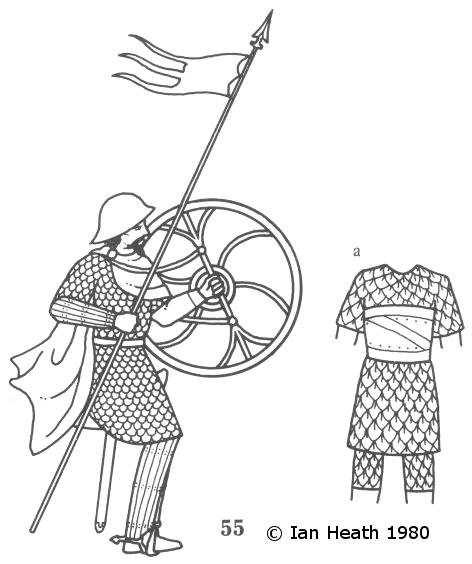
Create an Amazon Business Account
9TH CENTURY CAROLINGIAN HEAVY CAVALRYMAN
An extract from Armies of the Dark Ages 600-1066by Ian Heath



55. 9TH CENTURY CAROLINGIAN HEAVY CAVALRYMAN
This man represents an upper-class warrior. He wears a corselet called a brunia or broigne about the construction of which there has been some debate; it was probably often mail (the term lorica being sometimes used instead), but in contemporary illustrations corselets certainly look rather more like scales attached to a leather foundation, as depicted here. Either way the corselet was an expensive piece of equipment which few could afford, and for a long time corselets were obligatory only for men with estates of 12 mansi, while one capitulary (c. 802) made it obligatory for counts to have spare bruniae and helmets to equip their retainers. In addition splint-armour greaves called bagnbergae or bauga, of iron or less commonly leather, were in use at least as early as the late-8th century, while a single vambrace (manica) could be worn on the right arm, the left arm being protected by the shield, and a passage in Notker implies mail-strengthened gauntlets. Obviously, however, such additional armour would have been ever rarer than the corselet.
Some idea of the cost of such full equipment as is illustrated here can be got from the following assessment of 9th century arms in cows: the helmet was worth 6 cows; the brunia, 12 cows; sword and scabbard, 7 cows; greaves, 6 cows; spear and shield, 2 cows; and the horse, 12 cows. The total of 45 cows (which, admittedly, can be reduced to 15 by assessing in terms of the dearest cows) should then be compared to the bovine population of some of the richer individual royal estates, which had at the most only about 50 cows (excluding oxen, heifers and bullocks). Men as well-equipped as this were therefore probably in extremely short supply. This makes it very likely in turn that until about the mid-9th century figures such as 48 and 49 must have been provided by dismounted horsemen.
Leather or padded tunics similar to the bambakion (see note 3) or the quilted garment described under 68 were probably worn under the corselet from the beginning of this period as some protection against heavy blows which though unable to pierce the armour were still capable of breaking or fracturing bones or causing serious bruising. Such quilted tunics also prevented the armour itself from being driven into the flesh.
55a shows an alternative 9th century corselet with a strengthened leather breastplate worn over it. The thighs are also protected by scale armour, though this was not favoured by the Franks, who claimed it hindered their riding. Lamellar may also have been sometimes worn.
The lance, which varied in length between about 7 and 10 feet, was usually thrust overarm or hurled at this date (Charlemagne himself is described in one source as habitually carrying a throwing spear), though by the middle of the 9th century it is already sometimes shown couched as a lance. Sword, dagger and shield were also carried; the inner face of the shield is shown here, revealing the metal frame on which the orb was constructed, Carolingian shield bosses were prominent, protruding up to 8 inches.
One capitulary also includes in its inventory of arms a bow, 2 bowstrings and 12 arrows, while another demands more than one quiver of arrows. See comments under notes 50 and 52.